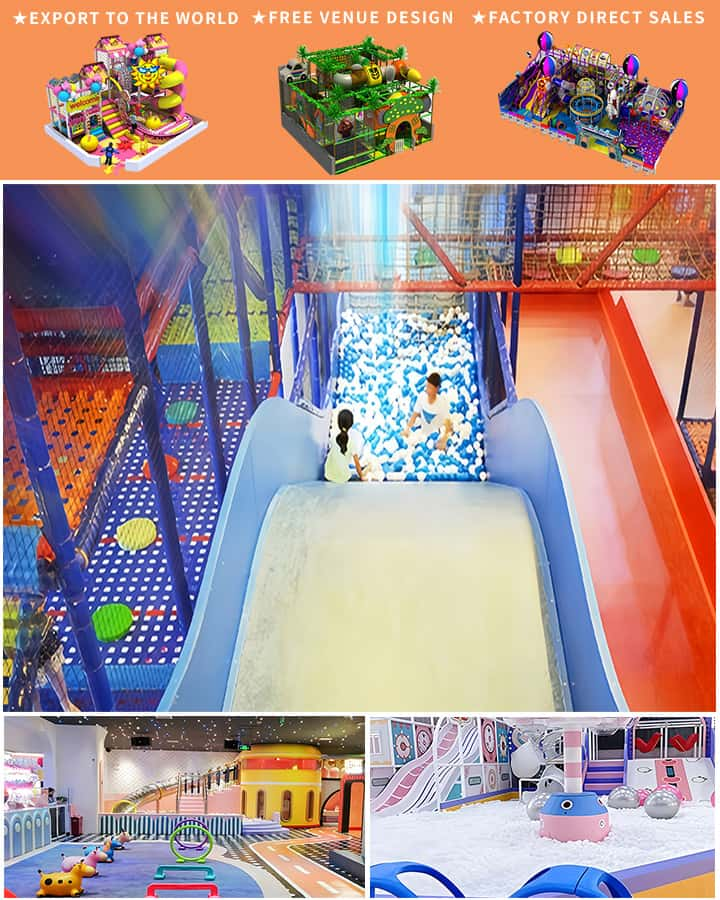Creating an indoor playground is a fantastic way to provide children with a fun, safe environment for physical activity and imaginative play. Choosing the right materials for your indoor playground is essential to ensure durability, safety, and aesthetic appeal. This comprehensive guide explores the various materials commonly used in indoor playground construction and offers insights into their benefits and considerations.
1. Plastics
Plastic materials are a popular choice for indoor playgrounds due to their versatility, cost-effectiveness, and ease of maintenance. High-density polyethylene (HDPE) and polypropylene are commonly used plastics that offer excellent durability and resistance to moisture, making them ideal for indoor environments.
Benefits:
Lightweight and easy to install.
Non-porous surface that is easy to sanitize.
Available in a wide range of colors and shapes.
Considerations:
Ensure that high-quality, non-toxic plastics are used to meet safety standards.
Avoid materials that may scratch or chip easily.
2. Wood
Wood is a timeless material known for its natural aesthetic and sturdy properties. Pressure-treated wood, plywood, and engineered woods like MDF (medium-density fiberboard) are often employed in indoor playground constructions.
Benefits:
Warm and inviting appearance.
Strong and durable with proper treatment.
Eco-friendly when sourced sustainably.
Considerations:
Needs regular maintenance to prevent wear and tear.
Must be treated and sealed to resist moisture and pest damage.
Can be heavier and more challenging to work with compared to other materials.

3. Metal
Metals like steel and aluminum are valued for their strength and longevity. These materials are often used in constructing frames, support structures, and climbing elements.
Benefits:
Exceptionally strong and long-lasting.
Resistant to environmental factors.
Can bear heavy loads.
Considerations:
Can be expensive compared to other materials.
May require professional installation due to weight and complexity.
Proper coating and maintenance are needed to prevent rust and corrosion.
4. Foam
Foam materials, particularly expanded polystyrene (EPS) and polyurethane foam, are widely used for flooring and padding in indoor playgrounds. They provide cushioning to reduce the risk of injury from falls.
Benefits:
Shock absorbent, reducing impact injuries.
Lightweight and easy to cut to size.
Available in various densities and thicknesses.
Considerations:
Needs to be covered with a protective layer to avoid direct exposure to moisture.
Can be damaged or deformed under heavy loads over time.
5. Vinyl
Vinyl is a flexible and durable material often used for flooring, coverings, and even some playground structures. It is favored for its ease of cleaning and slip-resistant properties.
Benefits:
Easy to clean and maintain.
Water-resistant and durable.
Offers good traction to reduce slips and falls.
Considerations:
Quality varies; choose high-grade vinyl for better longevity and safety.
Can be noisy underfoot without proper subflooring.
6. Rubber
Rubber materials, including recycled rubber tiles and mats, are commonly used for playground surfaces and flooring due to their shock-absorbing qualities.
Benefits:
High shock absorption reduces injury risks from falls.
Durable and weather-resistant.
Environmentally friendly when made from recycled materials.
Considerations:
May have a strong odor initially.
Prone to fading and color changes over time with UV exposure.
Can be heavy and require professional installation.
Final Thoughts
Selecting the right materials for your indoor playground involves balancing safety, durability, aesthetics, and budget. Each material has its unique characteristics, advantages, and potential drawbacks. By understanding these options, you can make informed decisions that contribute to creating a safe, engaging, and visually appealing space for children to enjoy. Always prioritize safety standards and consult with professionals when necessary to ensure your indoor playground is both fun and secure.




